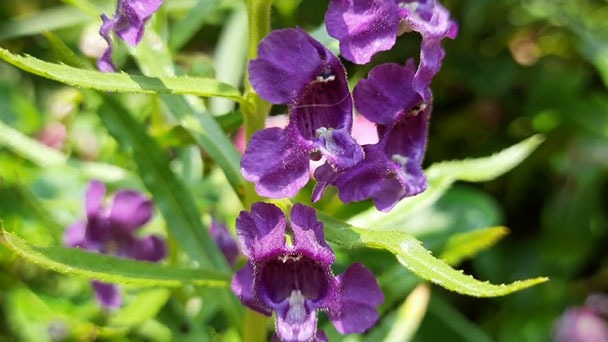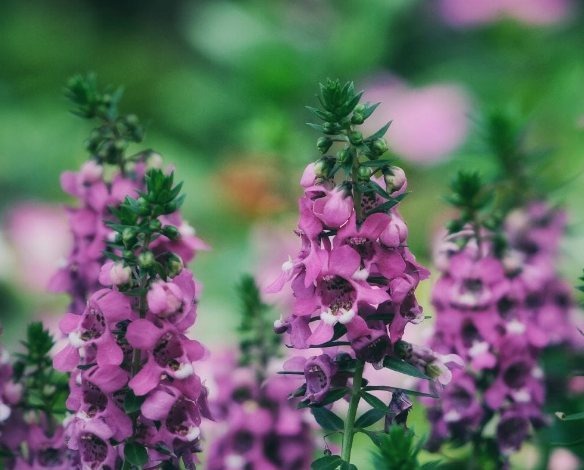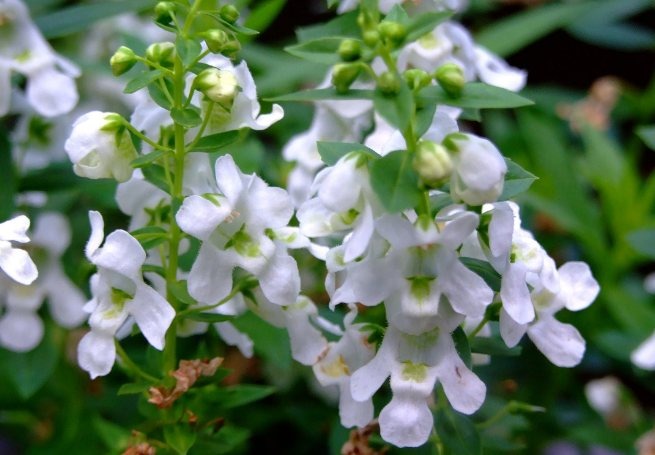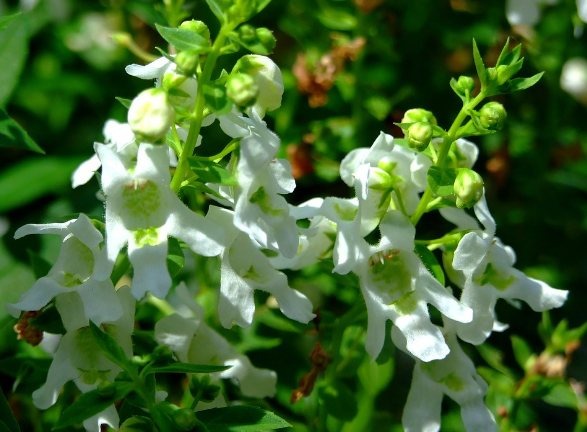How to Grow & Care for Willowleaf Angelon
Written by Ivy
Jan 06 2023

Although Willowleaf Angelon plants do best in moist, well-drained soil, they can tolerate brief dry spells, especially if compost has been added to the soil before planting. Maintain moisture in the soil around young seedlings. Once the plants are well-established, let the soil dry out in between waterings.
Basic Information of Willowleaf Angelon
- Zones: Hardy in zones 9-11; grown as an annual in colder zones
Height/Spread: Upright or spreading habit, 1 to 3 feet tall and 1 to 2 feet wide - Exposure: Full sun
- Bloom Time: Late spring through fall
- Flower Color and Characteristics: Numerous 3/4-inch flowers are produced on a single stem by vertical flower spikes that can grow up to 8 inches long. Flowers come in a variety of hues, including purple, blue, pink, red, lavender, coral, white, and bicolors. They have two lips and are slightly tubular in shape.
- Foliage: Green, narrow, lance-shaped leaves that range in size from 1 to 3 inches have marginal teeth. A slight apple- or grape-like scent that is more noticeable in the evenings permeates the foliage.
- Deer Resistance: Deer are thought to be resistant to angelonia, but under particularly harsh conditions, they might graze on plants they normally wouldn't.
| Common Name | Angelonia, summer snapdragon |
| Botanical Name | Angelonia angustifolia |
| Family | Plantaginaceae |
| Plant Type | Perennial in warm climates, grown as an annual in USDA zones 8 and lower |
| Mature Size | 18 inches tall, 9 to 12 inches wide |
| Sun Exposure | Full sun |
| Soil Type | Moist, fertile, well-drained |
| Soil pH | Acidic |
| Bloom Time | Summer |
| Flower Color | White, pink, mauve, violet, purple |
| Hardiness Zones | 9-11 (USDA) |
| Native Area | Mexico, West Indies, South America |

How to Grow Willowleaf Angelon
When to Plant
When there is no longer any risk of frost, plant in late spring.
Where to Plant
Grow Willowleaf Angelon in a container or outdoors on a site that gets at least six hours of direct sunlight daily.
How to Plant
Planting beds should be covered with a 2- to 3-inch layer of compost or another rich organic material. For containers, use high-quality potting soil. A loose, well-draining soil should be present. To promote a healthy plant's development, loosen any roots that are stuck in the pot. The plant should be positioned so the top of the root ball is level with the soil around it in a hole dug to the size of the root ball. Then, after thoroughly watering, gently tamp down the soil to remove any air bubbles.
How to Grow from Seed
Six to eight weeks prior to the last date of frost, start seeds indoors. In a sterile seed-starting mixture, lightly press the seeds. Do not cover Willowleaf Angelon seeds; they require light to germinate. Avoid allowing the soil surface to dry out by keeping it consistently moist. Use a heat mat if necessary; seeds need temperatures between 70 and 75 degrees to germinate. In 10 to 14 days, seedlings begin to show. Plants should be gradually acclimated to the outdoors before being moved into the garden once all threat of frost has passed. Wait until there is no chance of frost before direct sowing outdoors.
How to Care for Willowleaf Angelon
Pruning
Flowers clean themselves and don't require much deadheading. Spikes that have already been used can be removed, but it's not necessary. Cut back plants by half in the middle of the summer and fertilize.
Light
Willowleaf Angelon needs a lot of energy to bloom continuously, so plant it in full sun. Without at least six to eight hours of direct sunlight per day, plants will become tall and leggy and produce fewer blooms.
Soil
Rich, drained soil with a pH between 5.5 and 6.2 that leans slightly acidic is preferred by Willowleaf Angelon.
Amendments & Fertilizer
Compared to many other summer annuals, Willowleaf Angelon is a relatively light feeder. Use a time-release fertilizer as directed or apply a monthly all-purpose fertilizer. To keep weeds at bay and retain moisture, mulch plants with an organic material layer, such as compost.

Watering
Keep the soil evenly moist but not soggy. When the Willowleaf Angelon soil's top layer feels dry to the touch, water it. Until they become established, give plants 2 to 3 times per week of water. Once established, plants can tolerate some drought.
Temperature and Humidity
High humidity and sweltering summer temperatures are ideal for Willowleaf Angelon. They do best in the deep South, where humid weather rules. With a little extra watering, angelonia does well in the Southwest as well.
Fertilizer
Because Willowleaf Angelon plants are light feeders and excessive fertilizer will result in an overgrowth of foliage at the expense of flowers, fertilize them once a month. The need for additional fertilization can be avoided by providing plants with a light dose of flower fertilizer at the time of planting. Follow the directions on the product label for the appropriate amount to use.
Diseases and Pests
Willowleaf Angelon is essentially trouble-free when grown under ideal conditions and maintained properly. A gentle water spray can be used to get rid of pests like aphids. If the air isn't moving well or it's humid, powdery mildew may develop.
Potting and Repotting
Willowleaf Angelon plants are perfect for growing in containers due to their consistent blooming and orderly, self-cleaning habits. Use some pool or patio planters to capitalize on angelonia's attraction to butterflies and hummingbirds. Large containers, at least 18 inches in diameter, won't dry out as quickly as smaller containers.
In the late spring, when the evenings are warm, pot your angelonia plants. Use potting soil made for commercial use, which will have the proper amount of acidity and drainage. Because of its thin roots, Willowleaf Angelon can be grown as an annual without needing to be replanted. In order to replace the growing medium, repotter overwintered plants in the spring.

Overwintering
Willowleaf Angelonia is typically grown as an annual in colder climates, but container plants can also overwinter indoors. Bring it indoors once the nighttime low falls below 60 degrees Fahrenheit. Place it close to a window in a room that is consistently cool, at or below 65 degrees Fahrenheit, and where the plant receives bright, direct light. Watering it once a week will help to keep the soil moist. Move the plant outside as soon as the nighttime temperatures in spring start to rise to around 60 degrees Fahrenheit.
FAQs
What is the Difference Between Willowleaf Angelonia and Snapdragons?
The two plants belong to different genera. Willowleaf Angelonias don't come in warm yellow and orange hues like Snapdragons do, which are available in a wider range of colors than angelonias. While the tiny angelonia blossoms thrive in hot summer weather, the larger blooms on Snapdragons peak in the spring. Start with snapdragons for the longest flower display, and after the summer heats up, plant angelonias.
Where is Willowleaf Angelonia Native?
The West Indies and Mexico are the plant's original habitats.
Is Willowleaf Angelonia Winter-hardy?
Only in warm to hot climates does the delicate perennial Willowleaf angelonia make it through the winter. It is grown as an annual in the USDA Gold Hardiness Zones that are colder.
Conclusion
Even though Willowleaf Angelonia don't need regular care or deadheading, making an effort will make them look their best. Willowleaf Angelonia can benefit from monthly fertilization, as well as plenty of space and watering when the soil becomes dry.
Latest Updated
- Benefits of Bugleweed - 7 Science-backed Health Benefits
- Bugleweed Dangers & Side Effects - Is It Poisonous?
- How to Plant Evergreen Trees - What You Should Know
- When to Plant Evergreens - Grow Guide for Evergreen Trees
- 12 Wonderful Evergreen Shrubs for Your Garden
- 12 Popular Evergreen Plants with Pictures for Beginners
- When And How To Prune A Lilac Bush Like a Pro
- How to Grow & Care for Lilac Vine (Hardenbergia Violacea)
- Japanese Lilac Tree (Syringa Reticulata) Care & Propagation Guide
- Shumard Oak Pros and Cons - What to Know
Popular Articles
- Winter maintenance of Antirrhinum Majus
- How to Grow Terminalia Mantaly Tree
- How to Grow and Care for Crossostephium Chinense
- How to grow Antirrhinum Majus in spring
- Peristeria Elata (Dove Orchid) Profile: Info & Care Guide
- Underwatered Snake Plant (Sansevieria Trifasciata) - Signs And How To Fix
- How to Care for Brazilian Jasmine Plant (Mandevilla Sanderi)
- How to Grow & Care for Graptopetalum Purple Delight in Summer
- Rosa Chinensis (China Rose): Plant Growing & Care Tips
- How to Care for Baby Sun Rose (Aptenia Cordifolia)